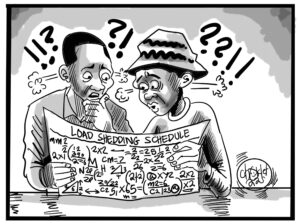ZESCO corporate affairs manager Dr John Kunda says the utility company is systematically ending load shedding by reducing the hours of power rationing.
In July last year, the utility company announced that it would completely end load shedding by December 2020.
Asked whether the utility had stuck to its pronouncement, Kunda said Zesco intended to end load shedding intelligently by slowly phasing it out.
“The answer to whether load shedding has ended is yes and no. We have seen gradual reduction of load shedding. The reason for load shedding was weather induced so we have been monitoring the weather patterns because we didn’t want to find ourselves in a situation where we are back to square one of 20 hours of load shedding. Or if we had a scenario where we had another drought, we wouldn’t want to find ourselves in a situation where we do not have any alternative for power generation. So load shedding has been very strategic. Now we have seen very good prediction both at regional level, Zambia, Angola and Zimbabwe as well. The prediction in the rainfall pattern has been very good and we have seen good inflows already so we have been reducing load shedding. We are systematically ending it in phases and in a gradual fashion. If you have noticed, we started from about 12 hours, we went into eight hours, six hours and then we went into zero to four hours,” he said.
“Where we are now, we are in a situation where people will be experiencing zero to six hours of load shedding and that is on the conservative side, but on the optimist side, it’s been ranging between zero to four hours. That’s the strategy. Now, moving forward, for the Christmas period we have tried to maintain zero load shedding because there has been a lot of power because as you know, once you produce power, you have to distribute it. If there is too much, demand that’s when you manage it. Our projected focus is to end it. But we want to end it intelligently because we are not in control of the weather, but so far the rainfall season is proving to be as predicted.”
He said it would be irresponsible for Zesco to go full throttle and increase generation just to end load shedding in the wake of increased rainfall patterns.
“We have increased generation and it’s all systematic. Otherwise, it would be irresponsible for us to say let’s go full throttle and end load shedding completely by increasing generations. We will have a clear picture by March this year. Otherwise, if this rainfall pattern continues, then by March, February this year we would have ended load shedding completely. Especially when we overcome the technical challenges at Kafue lower hydro power station. Remember we are slowly adding one machine after another. We are of course on course to start generation there once we overcome some technical challenges. Then one machine after another will be added and I can tell you that by the time we hit March, or even February we would have ended this completely,” said Dr Kunda.



















